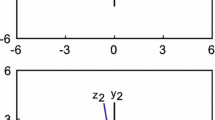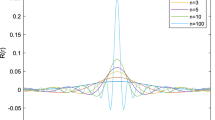Abstract.
A complex harmonic-oscillator basis is employed for the three-body problem obeying S 3-symmetry. Unlike a real basis it generates an additional quantum number (N a ), in addition to the standard principal quantum number (N), and thus facilitates a more quantitative S 3-classification of the various states than is usually possible. It is shown that certain bilinear forms with definite S 3-symmetry properties, which can be constructed out of the linear harmonic-oscillator operators (a, a †) satisfy several uncoupled sets of SO(2, 1) algebras with spectra bounded from below. It is also briefly indicated how this S 3-formalism can be adapted to the core structure of a more general relativistic three-particle system with unequal-mass kinematics through an appropriate choice of internal variables.
Similar content being viewed by others
Author information
Authors and Affiliations
Additional information
Received May 11, 1994; revised November 3, 1994; accepted for publication November 23, 1994
Rights and permissions
About this article
Cite this article
Mitra, A., Sharma, A. & Mitra-Sodermark, B. Complex Harmonic-Oscillator Basis for the Relativistic Three-Body Problem. Few-Body Systems 19, 145–156 (1995). https://doi.org/10.1007/s006010050022
Issue Date:
DOI: https://doi.org/10.1007/s006010050022




